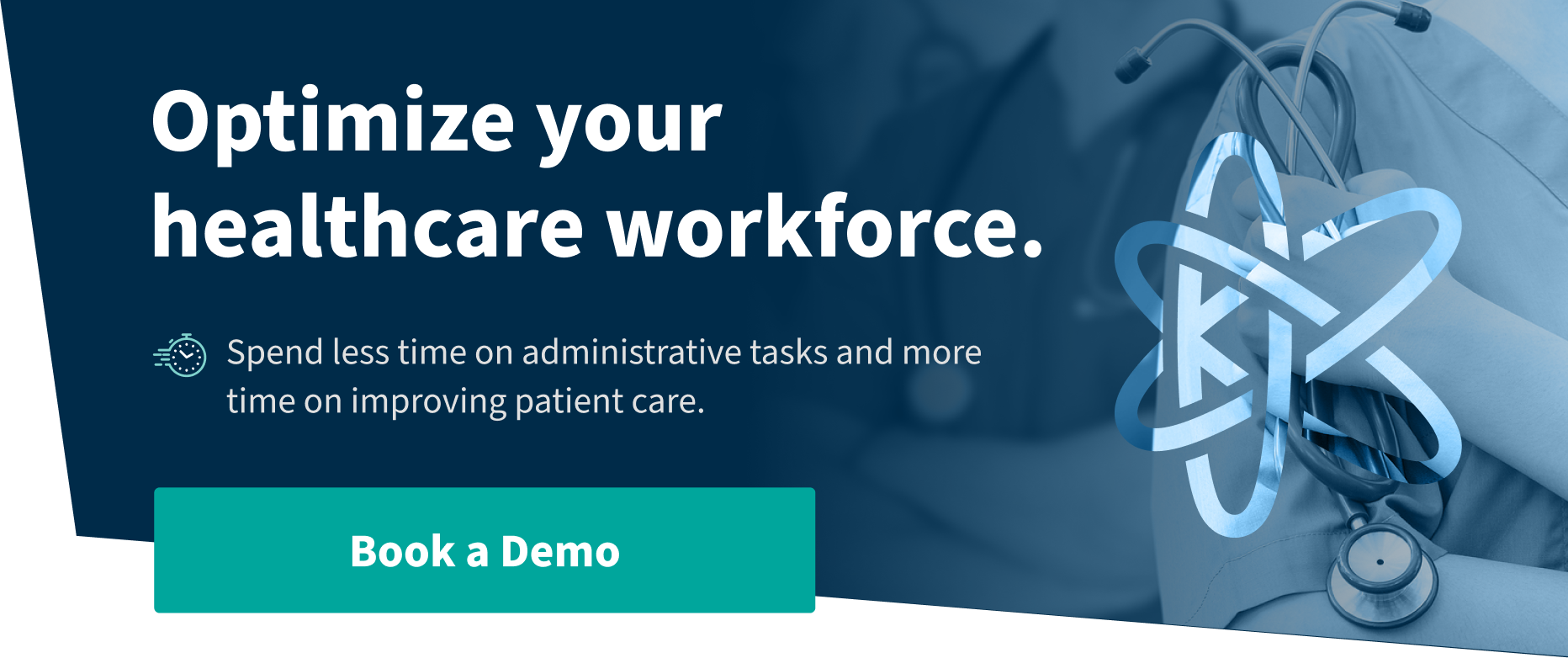Burned out. Overworked. Underappreciated. If these words describe how your healthcare clinicians feel, you have a serious problem with clinician satisfaction. Disengaged doctors lead to poor patient care, high turnover rates, medical errors, and more. Clearly, keeping your clinicians happy and engaged should be priority one.
Unfortunately though, with all of the chaos that often makes up healthcare systems, boosting clinician satisfaction often takes a backseat to more visible metrics like patient volumes or hospital rankings.
Many administrators barely have time to ask if their physicians feel fulfilled or that they have any semblance of work-life balance. Sound familiar? If you can relate, keep reading...
What is Clinician Satisfaction?
Clinician satisfaction refers to the overall contentment, engagement, experience, and happiness of clinicians working within a healthcare organization. In other words, it focuses on the wellbeing and fulfillment of doctors, nurses, technologists, and other medical staff.
Specifically, clinician satisfaction measures how valued, appreciated, supported, and pleased clinicians feel in their day-to-day work delivering patient care. It directly traces back to the workplace culture, communication methods, flexibility, tools, and processes that either uplift or degrade the clinician experience.
Why does clinician satisfaction matter so much?
Disengaged doctors lead to a cascading set of issues that undermine care delivery across hospitals and health systems. Discontent clinicians deliver poorer quality care and have higher risks of medical errors. They leave patient questions unanswered and empathy unchecked which erodes the care experience. Disengaged physicians also have sky-high turnover rates that strain recruitment budgets and reinforce staff shortages when colleagues follow them out the door.
In contrast, satisfied clinicians energize colleagues and inspire outstanding care experiences. They become partners in driving change through new initiatives rather than barriers clinging to old ways. Satisfied staff advance innovation that lifts community perceptions and brand equity beyond new buildings or technologies alone.
4 Common Indicators of Clinician Satisfaction
Given the importance of keeping your physicians, nurses, and other clinicians satisfied at work, many healthcare administrators question what that actually looks like at their organizations. How can you accurately measure, evaluate, and improve satisfaction across dozens of different roles and personalities?
While no two clinicians share the exact same values or motivators, our research has uncovered four key clinician satisfaction indicators that lift clinician contentment regardless of role or responsibilities. They are:
1) Streamlined onboarding processes,
2) Flexible communication platforms,
3) Collaborative scheduling systems, and
4) Timely and accurate payments.
Let's explore each indicator in more detail so you can work on raising clinician satisfaction in your own healthcare organization!
1. Streamlined Onboarding Processes
Let’s say a new doctor has been hired. They are likely eager about their new opportunity. Instead of jumping right into work however, they might have to wait a long time between their hire date and start date. This is because of things like privileging, antiquated forms that need signatures, manuals in need of reviewing, and restrictions on system access.
Clunky, paper-driven onboarding remains the norm across too many health systems. The typical physician spends over 20 hours completing forms for new hospital appointments—and that’s after they get hired!
It’s better to streamline onboarding using smart forms that auto-populate information to reduce the data rehash. Structured onboarding checklists that verify compliance steps remotely also prevent frustration. Platforms that automate credentialing workflows speed inclusion while giving new clinicians full transparency where approvals stand.
2. Flexible Communication Platforms
The average healthcare clinician now interacts with three to five healthcare organizations and even more departments. Both communication overload and mismatching channels are rampant problems. Smaller groups still rely on spreadsheets to indicate contact preferences, proving difficult to scale while risking security issues and onboarding lags from manual efforts.
Modern tools like Kimedics provide self-service options for clinicians to set, update, and manage their own communication preferences by group, role, location etc. A big draw of Kimedics is also that it allows a clinician to get set up with a personal email. We hear a lot of people say clinicians will actually not open their company email because they work with so many healthcare organizations. Therefore, having a clinician’s personal email in the system helps ensure you can reach them (and get a response!) in a timely manner.
3. Collaborative Scheduling Systems
Few clinician gripes share the same blistering intensity as scheduling complaints due to issues such as:
- Inflexible calendars
- Last minute admin-led changes
- The logjam fighting over popular holidays off
- Paper-based requests that delay approvals for weeks
- Sudden shifts appearing without consent
It's no wonder outdated and one-sided scheduling systems crush satisfaction while increasing burnout risk. Yet many major health networks still rely on exasperating processes and tools that rob clinicians of control.
You need a collaborative platform that places power back in the clinicians' hands. Clinicians manage calendars and shifts directly via convenience-driven mobile apps. Admins retain guardrails and oversight but time otherwise wasted getting approvals accelerates patient care. Open shift slots trigger internal bidding from cross-departmental colleagues eager for extra work. External agencies likewise gain visibility to fill last minute staffing gaps, complete with two-way messaging driving faster confirmations.
4. Timely and Accurate Payments
Whether it's delays in receiving payment, arguments over base compensation or bonuses, or the dreaded "payroll correction" notice wiping out supposed earnings, cash flow confusion can destroy clinician satisfaction.
Behind the scenes, poor integration between scheduling software (if it even exists) and backend payroll processors perpetuates these problems. Verifying actual hours worked against pay rates and shift differentials gives way to manual guesses instead of automated precision. Errors pile up causing costly rework and clinician pushback.
Modernized workforce solutions like Kimedics mitigate the issue through real-time connections of verified staff hours to compensation managers. No more checking spreadsheets and playing phone tag hoping for answers.
How Workforce Management Affects Satisfaction - 4 Opportunities for Improvement
There are four key opportunities to improve clinician satisfaction in your healthcare organization. These include:
- Automating Administrative Processes
- Enabling Self-Service Scheduling
- Expanding Scheduling Collaboration
- Tightening Payroll Integrations
Let's examine how these four technical avenues directly uplift the clinician experience across roles and responsibilities for an engagement boon right out of the gate.
1. Automating Administrative Processes
Smoothing administrative hassles through workflow automation clears major bottlenecks to free up clinician focus fast. This pain point alone pulls physician attention away from patients instead of paperwork when starting a new position.
Sophisticated workforce platforms like Kimedics sideline this anguish through real-time integrations with leading HRIS and credentialing systems out of the box. Robust rules engines similarly automate clinician requirements for items like licenses and insurance by specialty, location, and more to avoid chasing down details.
The result? A drastically slimmed down onboarding process where clinicians spend minutes, not hours/weeks.
2. Enabling Self-Service Scheduling
Through convenient mobile access, clinicians of all types can use Kimedics to customize schedules and shifts to align with their evolving availability and needs. Paired with configurable rules engines guaranteeing proper coverage ratios are still met, scheduling flexibility grants relief over one of the largest workplace stress points clinicians share today. Gain peace of mind through scheduling technologies that finally provide work-life balance back to overburdened yet invaluable clinicians.
3. Expanding Scheduling Collaboration
Even the most advanced scheduling systems enabling clinician self-service cannot fully prevent last minute needs from arising. Patient volumes fluctuate. Late notice PTO gets requested. Significant life events throw work routines for a loop. So what happens when schedule gaps inevitably emerge?
Savvy healthcare groups use Kimedics to tap into expanded scheduling collaboration to fill open shifts faster using internal and external resources. Integrated peer-to-peer shift posting facilitates internal cross coverage across departments in real-time. Multiple clinicians receive alerts for open assignment matches to their specialty, availability, hospital location and other attributes – prompting rapid shift claims for colleagues happy to take on more work.
External staffing agencies likewise gain visibility into upcoming schedule vacancies through system integration or structured data sharing workflows. Agency clinicians contained in master profile directories see aligned open shifts alerts using smart matching.
Note: With Kimedics, only the open shifts clinicians have been given permission to view will be accessible. We understand how important it is to control the visibility you give to the agencies you work with.
Our workforce relationship management platform provides faster shift booking communication cycles between agencies and healthcare system admins over traditional email and phone tag. As a result, schedule gaps get plugged faster than ever!
4. Tightening Payroll Integrations
Verifying actual hours worked against accurate pay rates can cause massive headaches due to disparate systems and data inputs. Kimedics can solve the issue through real-time synchronizations of worker hours completed and compensation profiles. Platform prompts requiring clinician confirmations on shift duration prior to closing payroll periods eliminate surprises. Rule validations warn admins when outlying pay rates beyond expected ranges get entered to avoid problems. Automated off cycle payment functionality reduces lag for items like bonuses or clinical trial compensation requiring faster processing as well.
Clinicians gain confidence around billing rates accuracy, hours logged properly, and change histories across locations should questions arise. Payroll transparency secured through system integration adds the finishing touch delivering clinicians the fair and timely payments they deserve.
Improve Your Clinician Satisfaction Rates
As pressures mount across health systems today, far too many administrators lose sight of the clinician satisfaction indicators that directly feed into the clinician experience. By zeroing in on streamlined onboarding, flexible communications, collaborative scheduling, and timely payments, healthcare leaders can right the ship steering hardworking clinicians into disengagement.
Isn’t it time your organization re-focused its efforts on fulfilling the awesome clinicians making life-saving patient care possible each day? Book a guided demo of Kimedics now to discover first-hand how re-centering tools around the clinician pays off tenfold through workforce unity unmatched across healthcare.




